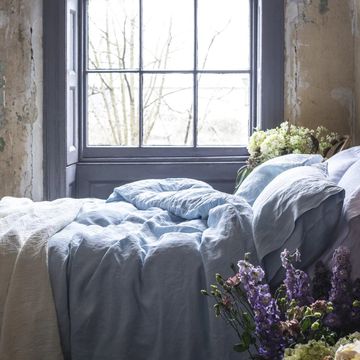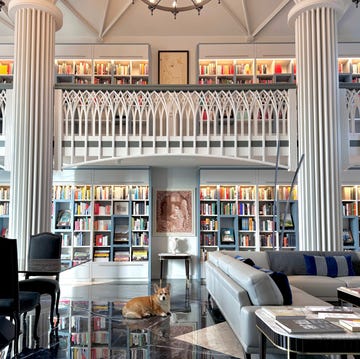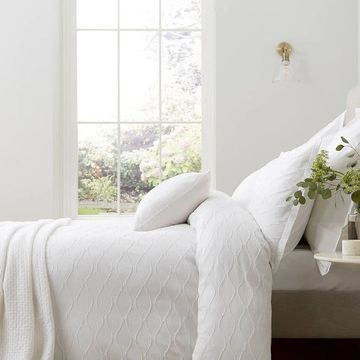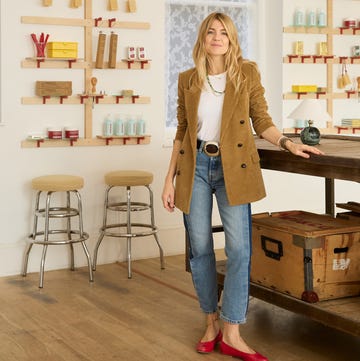Beyond a gated London mews and the security guard’s cottage, through the portals of baroque wrought-iron gates, a driveway leads past a secret garden to a white-columned mansion. A portico opens onto a glass-domed courtyard-style living-room; into this pool of light and colour steps Patricia Caring, in jeans and a classic trench. She is effortlessly glamorous, even while wearing a pair of fluffy slippers to protect the parquet, marble and bespoke Pierre Frey carpets. The new villa has been more than five years in the making; a fresh canvas for Patricia and Richard Caring, her husband of seven years and the hospitality king behind restaurants such as Annabel’s, Sexy Fish and the Ivy group. He is, she says, a perfectionist, as obsessed about the detail as she is, which is perhaps why they consider the house still a work in progress – with every single piece of furniture chosen together in auction or specially commissioned.
The 18,000-square-foot, low-slung property sits on the footprint of a pair of demolished early-19th-century cottages that belonged to Lady Annabel Goldsmith and Mark Birley, who founded Annabel’s in 1963. Patricia, who became the co-chair of Birley Clubs in 2020, says the attraction was always the secluded location. Lady Annabel also adored this verdant sanctuary, describing it in her memoir No Invitation Required as a hidden oasis, only yards from South Kensington station.
An oasis it still is, especially with the light filtering through the courtyard atrium, out of which all the rooms of the house radiate. A love of colour, gardens and animals unites Richard Caring’s British and Patricia’s Brazilian heritage. From the vivid ceramic iguanas and parrots clasping lampstands to the leafy motifs picked up in the emerald borders of carpets, as well as the elaborate metal ivy trails in the neoclassical balustrades and the floral-themed wraparound plaster frieze beneath a Lalique-style glass foliage screen, the unapologetic maximalism, exuberant style and the retractable glass ceiling are an echo and evocation of the Martin Brudnizki-designed Annabel’s club.
“Annabel’s is so special to us,” says Patricia. It is the name of their third child; it is where they met; and it was in what became the Rose Room of the new unfinished club site that Richard proposed. “He tricked me into checking on the progress of the construction first, and filled the room with candles, one table and a violinist,” she adds. Annabel’s, together with the Birley Club brand, is also the platform from which Patricia launched and synchronises the philanthropic arm of her business. This, the Caring Family Foundation, is a three-pillar concern that focuses on the restoration and reforestation of the Amazon, and alleviating domestic abuse and child poverty. During last year’s ‘Amazon month’ at Annabel’s, her gala event raised £2.4 million for the cause. In her self-defined role as protector and nurturer of the Foundation, she thinks of it as her fifth child – or actually, her sixth, she says with a smile, if she includes her “soul-mate” Richard alongside their three pre-teens and toddler.
The sense of family – and the clue is in the Foundation’s name – is patently important. As an only child, brought up by her grandmothers in a middle-class household in southern Brazil, Patricia dreamt of having a large brood. The room in which she spends the most time is the kitchen, where six well-behaved Yorkies reside. Sliding doors give onto the garden, the playroom and the kids’ TV room, and also to her office, where she can survey all goings-on. She loves the flow of these interconnecting spaces, which remind her of the Four Seasons Hotel George V in Paris.
Home, for her, is the smell of sizzling garlic, of coffee and baking bread in the kitchen, which satisfies her hankering for all things “cosy”. One of the objects she treasures the most is a carved cot from Italy in which all four children have slept and which she hopes will become a family heirloom. She has imported other reminders of her homeland, such as a small glass frog displayed in the living-room to sit alongside Richard’s impressive collections of rare antiques.
His ‘man cave’, as Patricia calls her husband’s low-lit basement space, displays a complete set of The Sporting Magazine from the late 1700s, a precious sancai-glazed large Tang Dynasty horse and a rare Samurai warrior from the Edo period, alongside masterpieces by the French 19th-century painter Alfred de Dreux. Other pieces from the art collection – Arlequin à la Lune Jaune by Marc Chagall; Damien Hirst’s 2023 work True Garden – take centre-stage in large reception areas. These rooms are made for entertaining, Patricia concedes, but so far, in the two years they have been here, they’ve only managed to host children’s birthdays.
There is never enough time, either, to enjoy the swimming pool, which also serves as a ballroom, a spa and cryochamber, or to sit with Richard and watch something – a sports enthusiast, he has a television in the majority of the rooms. The space that lights her up most, though, is the downstairs loo, with a whimsical mural of a Brazilian sky filled with orchids, hummingbirds and a view of Rio’s Christ the Redeemer. “It was a sweet surprise from Richard; to bring a bit of my country to the home,” she says, recalling how he barred her from entry until its completion and then revealed it to her in a grand flourish.
When I marvel at the jaguar-shaped basin, she informs me it is a powerful symbol of the Amazon, a guardian representing resilience and courage. Is that also how Richard sees her, I wonder? She acknowledges that Brazilian womanhood is all about the strength beneath the legendary warmth. And Patricia is in awe and admiration of the resourcefulness and generosity of the indigenous women with whom she collaborates.
Over fresh ginger tea, she confides her instinct for giving back stems from growing up under a dictatorship with galloping inflation, raging poverty and glaring inequalities. So, when she married Richard in 2018, she scouted for a meaningful way in which she could combine the business of hospitality with a philanthropic vision. There’s a natural synergy: “In both cases, it is about taking care of people, it is about community, and giving the best service and respect to those communities.”
Then came the pandemic, which required immediate action; the Carings responded with their One Million and One Meals campaign, delivering food to NHS key workers and families in need. In the process, the Caring Family Foundation was born and Patricia found her calling. In her wildest dreams, she could never have imagined the Foundation would feed over three million people, support more than 13,000 abused women or plant 2.3 million trees in the Amazon. I ask what her vision is for the Foundation’s future and she shrugs. “This is like war work – it’s about a child who needs to be fed now; a mother who needs protection now…
“Come back in five years and ask me again, and I may be able to tell you,” she says, as she accompanies me to the front door. She herself will soon be off, bringing volunteer mobile medics to the Pirahã people in the remotest Amazon, a community so removed from the outside world they exist without language, or an idea of numbers or time. It is, obviously, a very different universe from the rarefied urban circles she moves in. “I’m as terrified of being mugged on São Paolo’s streets as I am of anacondas,” she says. “But we are here to conquer these fears.”
Top image features ‘Arlequin à la Lune Jaune’ (1187–1985) by Marc Chagall. © ADAGP Paris and DACS, London 2025


















